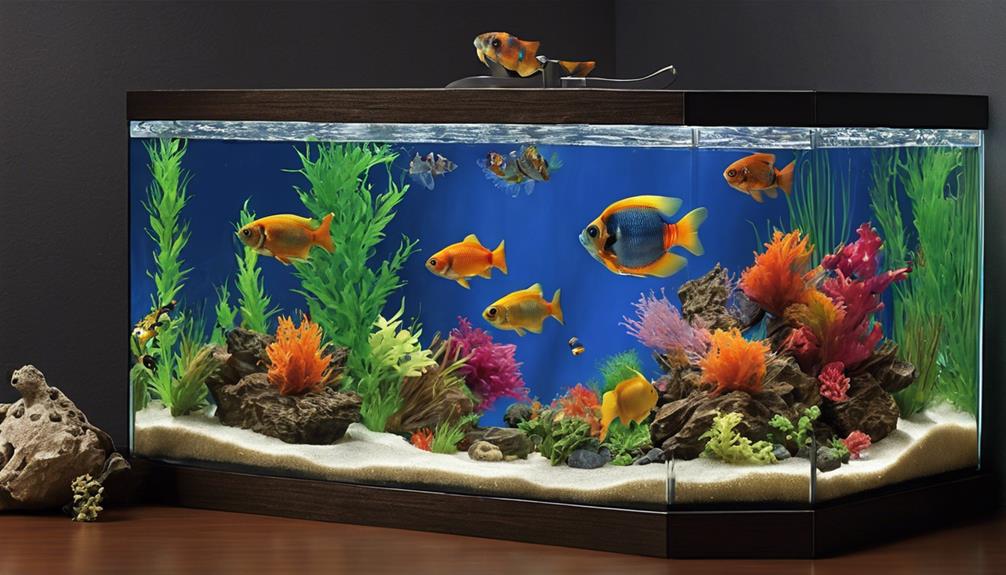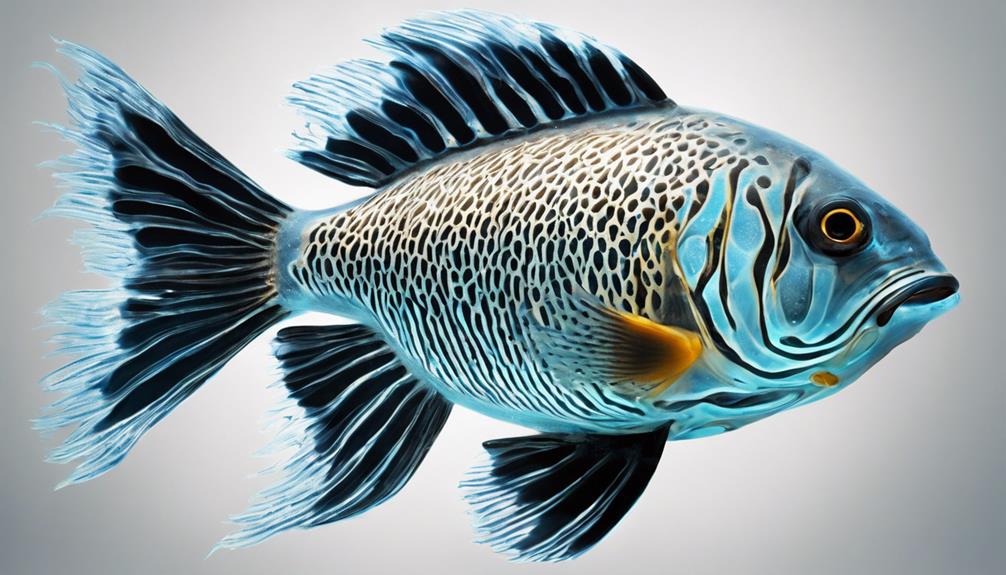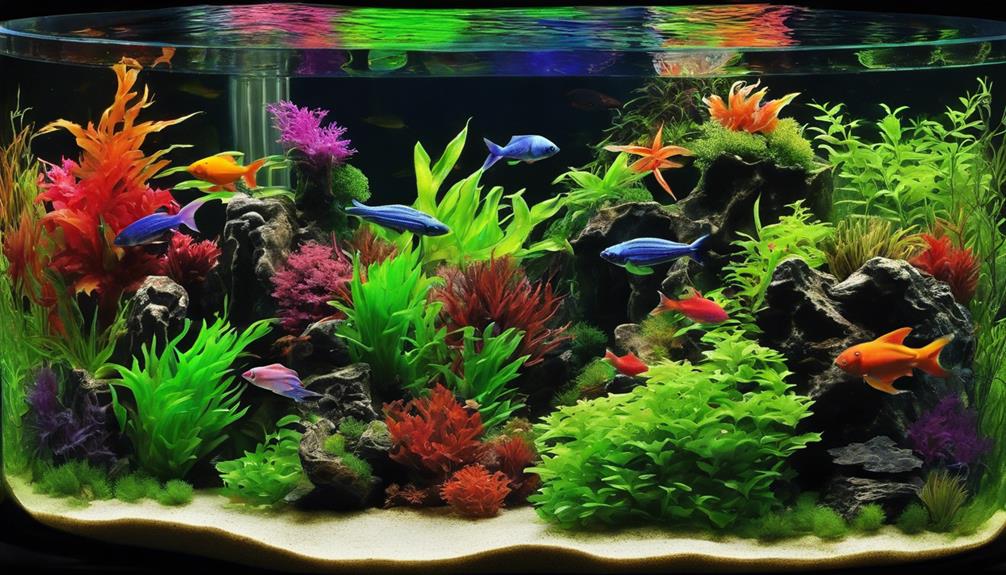If your fish is staying in one spot, it might be a sign of distress. Watch for appetite changes, swim patterns, and tank interactions. Check water quality and decor influence; gill health is key for respiration. Track swimming activities and color changes for hints. Reduce stress with a diverse tank setup and a balanced diet. Regular monitoring, routine maintenance, and vital tactics are essential for a healthy aquarium. Understanding these aspects will help promote active behavior in your fish. More insights on creating an engaging environment and ensuring fish well-being await.
Key Takeaways
- Check water quality for issues affecting fish behavior.
- Ensure proper tank layout and stimulation for active swimming.
- Monitor fish for signs of distress or illness.
- Provide hiding spots and varied environments to reduce stress.
- Maintain a balanced diet to support fish health and activity.
Common Signs of Fish Distress
When observing fish behavior, it's important to be aware of common signs of distress that may indicate underlying health issues. One key indicator is when your fish stays at the bottom of the tank for extended periods. If your fish is usually active and swimming around but suddenly prefers the bottom, it could be a sign of distress. This behavior might suggest discomfort or illness, prompting a closer look at the water quality and the fish's overall well-being.
Ensuring your fish have good water conditions is vital for their health. Poor water quality can stress fish, leading to behaviors like staying at the tank's bottom. Monitor your fish for signs of distress and promptly address any water issues to help them thrive.
Additionally, observing your fish swimming around actively is a positive sign of well-being. If your fish is lively and exploring their environment, it usually indicates good health and contentment.
Watching for Appetite Changes

Monitoring fish appetite is important for detecting early signs of health issues and guaranteeing their well-being. Changes in appetite, such as an increase or decrease in feeding habits, can indicate underlying problems affecting fish behavior.
By regularly observing their eating patterns, you can detect signs of illness, stress, or poor water quality. Consistent feeding routines are essential for evaluating the health of your fish.
A loss of appetite in fish can lead to energy deficiency and weaken their immune systems, making them more susceptible to diseases. Hence, it's critical to pay attention to any appetite changes in your fish to address potential issues promptly.
Being Aware of Fish Behavior

When observing fish behavior, it's essential to pay attention to their movements and habits. Understanding how fish normally behave can help us recognize when something is amiss.
Being aware of changes in swimming patterns or unusual stillness can provide valuable insights into their well-being.
Observation Tips for Fish
Engaging with fish behavior involves keen observation of their swimming patterns, interactions with tank mates, and responses to environmental changes.
To effectively observe your fish, pay attention to their movements at different levels of the tank. Note if they're swimming near the bottom, which could indicate potential health issues or stress.
Watch for any unusual behaviors such as excessive hiding or sudden aggression towards other fish. By documenting these observations, you can track any changes over time.
Remember to also observe their feeding habits, coloration, and activity levels as these can be signs of underlying problems. Regular monitoring will help you establish a baseline for normal behavior and quickly identify any deviations that may require attention.
Understanding Fish Movements
To understand fish movements effectively, it's essential to consider how various factors such as tank layout, decor, and lighting influence their behavior. Fish behavior is intricately connected to efficient water flow within the tank. Proper water circulation is crucial for maintaining ideal oxygen levels, regulating temperature, and encouraging natural fish movement.
The positioning of essential equipment like heaters and filters also plays a significant role in shaping fish behavior. Water flow from filters, powerheads, and air pumps not only affects fish comfort but also influences their overall well-being. Balancing the water flow to prevent stagnant areas is key to ensuring a stimulating environment that promotes active fish behavior.
Understanding these dynamics can lead to a more enriching and fulfilling experience for both you and your aquatic companions.
Understanding Respiration Patterns

Fish respiration is an important aspect of their survival. It involves the exchange of oxygen and carbon dioxide through their gills. Understanding the variations in breathing frequency and the significance of maintaining healthy gills is essential for keeping fish in peak condition.
Breathing Frequency Variations
Understanding variations in breathing frequency is essential for monitoring the health of fish and detecting potential issues early. Fish species, water parameters, stress, and illness can all influence respiration patterns. To emphasize this point, consider the following table:
| Factors Affecting Respiration | Examples |
|---|---|
| Fish Species | Betta fish vs. Goldfish |
| Water Parameters | Temperature, oxygen levels |
| Stress or Illness | Sudden changes, infections |
Importance of Gill Health
Gill health plays an essential role in ensuring fish can effectively extract oxygen from water for respiration. The gills act as the primary site for oxygen exchange, allowing fish to breathe underwater. Healthy gills are critical for maintaining proper oxygen levels in the fish tank, supporting metabolic functions and overall well-being.
Monitoring gill movement is a key indicator of oxygen intake and respiratory efficiency. Damage to the gills can hinder respiration, leading to stress and health issues in fish. Maintaining good water quality is indispensable for excellent gill health. By ensuring a clean and well-aerated environment, you can help your fish thrive and exhibit active behavior in their habitat.
Monitoring Swimming Activity

When monitoring swimming activity in fish, it's crucial to track both the frequency and duration of their movements throughout the day. By observing how often and for how long your fish swims, you can gain valuable insights into their overall health and well-being. Changes in swimming patterns, such as increased activity or sudden bouts of lethargy, could indicate underlying issues like swim bladder problems or stress.
To effectively monitor swimming activity, note the areas in the tank where your fish prefers to swim. This can give you a better understanding of their habitat preferences and behavior. Additionally, observe how your fish interacts with tank mates while swimming to make sure they aren't being harassed or bullied, leading to stress.
Incorporating partial water changes into your routine can also help maintain ideal water quality, reducing stress levels for your fish and promoting healthy swimming behavior. By staying attentive to your fish's swimming activity and behavior, you can make sure they're happy and thriving in their aquatic environment.
Noting Changes in Fish Color
Noticing alterations in fish coloration is an essential aspect of monitoring their health and well-being. Fish color changes can provide valuable insights into their overall condition, serving as indicators of potential stress, illness, or environmental factors impacting their health.
Bright and vibrant colors typically signify important health, while pale or faded colors may suggest underlying issues that require attention. It's vital to pay attention to sudden color changes, as they can be warning signs of possible health problems that need immediate intervention.
Regularly monitoring your fish's color can help in detecting any abnormalities early on, allowing for timely action to be taken. By staying observant and noting any changes in their coloration, you can better understand your fish's well-being and make sure they remain happy and healthy in their environment.
Strategies to Reduce Stress

To effectively reduce stress in fish, providing hiding spots and stimulation is essential. Creating a diverse environment within the aquarium can help mimic their natural habitat and alleviate stress. Hiding spots, such as plants or caves, offer fish a sense of security, allowing them to retreat when feeling overwhelmed. Introducing stimulation through the addition of tank mates or rotating decor can also prevent boredom and reduce stress levels in fish.
Monitoring water quality is important in addressing potential stressors. Poor water conditions can lead to health issues and heightened stress levels in fish. Regular water testing and maintenance guarantee a clean and stable environment for your aquatic pets.
In addition to environmental factors, offering a balanced and nutritious diet is essential for supporting fish well-being. A varied diet rich in essential nutrients helps boost immune systems and overall health, reducing susceptibility to stress-related illnesses.
Planning for a Healthy Aquarium

Moving from addressing stressors to fostering a thriving aquatic environment, establishing a solid plan for a healthy aquarium is key. Regularly monitoring tank water parameters such as pH, ammonia, and nitrite levels is essential for maintaining water quality.
Creating a consistent routine for feeding, cleaning, and maintenance helps to sustain a harmonious tank environment. Proper planning and preparation for any changes in the aquarium can prevent stress and guarantee the well-being of your fish.
It's vital to implement stress-reducing techniques like providing hiding spots and selecting suitable tank mates to promote fish activity. Additionally, ensuring a balanced tank environment with appropriate decor, lighting, and high water quality supports the overall health of your aquarium inhabitants.
Frequently Asked Questions
What Does It Mean When a Fish Stays in the Same Spot?
When my fish stays in one spot, it may indicate stress or discomfort. Checking water quality and providing stimulation can assist. Observing behavior changes is vital for their health. Addressing underlying issues guarantees their well-being.
Why Is My Fish Suddenly so Active?
Feeling amazed at my fish's sudden burst of energy? Changes in the environment, like temperature and tank setup, can spark their activity levels. A diverse diet and engaging surroundings can also encourage their lively behavior.
Why Do Fish Stay in Their Zone?
Fish stay in their zone due to stress, discomfort, or feeling threatened. Water quality issues, inadequate hiding spots, and lack of stimulation can contribute. Changes in behavior signal underlying problems. Monitoring behavior closely is key for addressing issues.
What Does It Mean When a Fish Isolates Itself?
When a fish isolates itself, it could signal stress, illness, or discomfort. Monitoring behavior is key. A safe, stimulating environment matters. Addressing underlying issues is essential. Ensuring good water quality and suitable hiding spots helps.
Conclusion
To summarize, it's important to pay attention to the behavior of your fish in order to guarantee they're healthy and happy.
Did you know that a healthy fish should swim actively throughout the day, covering about 10-20 times its body length in distance?
By monitoring their behavior, respiration patterns, and color changes, you can identify any signs of distress and take action to minimize stress in your aquarium.
Remember, a happy fish is an active fish!










